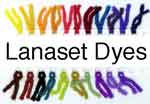How can I dye my mustard-colored terrywool trousers?
—ADVERTISEMENT—
Color polyester blends with fabric paints
The best dyes for wool
Buy from
Paradise Fibers
Message: I have a very costly terrywool trouser which is mustard color. I want to dye it in some other suitable color. Which color will be most suited and what type of dye will be best?
From what I read, the fabric called terrywool is actually a blend of 35% Merino wool and 65% polyester. Wool plus polyester is a difficult fiber blend to dye.
The only way to dye the polyester is with a special dye called disperse dye; no dye that works on wool will work at all on polyester, as it will just wash out of the synthetic fiber. However, the extensive boiling required to dye polyester with disperse dye is apt to shrink and possibly felt your trousers. It is best to dye a terrywool polyester/wool blend in the form of fabric, before the material has been sewn into a garment, so that the shrinkage is not a problem. It's likely that the polyester fiber is normally dyed in thread form, before it is ever mixed with the wool at all. See "Dyeing Polyester with Disperse Dyes".
If you ignore the polyester in the blend, and just dye the wool, you may end with a sort of heather effect, in which the wool fibers are much darker in color than the polyester fibers, which remain unchanged. You might find the mustard color of your trousers improved by this. How do you think it would look if you dyed only the wool in the blend a dark brown, say? You can do this by use of acid dyes, such as Lanaset dye. See "Dyeing Protein Fibers".
Dyeing even just the wool in your poly/wool trousers will require that you obtain a very large cooking pot, large enough for the garment to move freely in the water-plus-dye mixture you then put in the pot. Ten gallons is a good size. The pot should not be made of a reactive metal such as aluminum or iron; the only acceptable materials are stainless steel or enameled. After you use this pot for dyeing, you should not reuse it for cooking food, because textile dyes are not tested for safety when used on food preparation surfaces. All textile dyes should be assumed to contaminate cooking pots. A ten-gallon stainless steel or enamel dyeing pot is a significant investment. If you are going to be doing a lot of hot-water dyeing, it's an excellent investment, but the cost is too high to be worthwhile if the only item you will be dyeing is this one pair of trousers.
The remaining alternative way to color your trousers is by means of fabric paint. See "Fabric Paints: a different way to color fibers". The advantages are that you do not have to boil the fabric paint to set it, but instead only to press it with a hot iron, so neither shinkage nor the expense of a dyepot are issues, and that some brands of fabric paint will work on synthetic fibers such as polyester at the same time that they work on natural fibers such as wool. However, fabric paint, or pigment dyeing, never results in a perfectly smooth solid color, however; if you try to pigment-dye your trousers with fabric paint, such as Dharma's Pigment Dye System, you will find that the results are not perfectly even. The look of pigment dyeing on cotton is fashionable for its "instant age" effect, but it is probably not what you have in mind for your terrywool trousers.
(Please help support this web site. Thank you.)
Posted: Friday - October 17, 2008 at 06:55 AM
Follow this blog on twitter here.
- Top of this blog -
- FAQ -
- The Dye Forum -
- How to Tie Dye - How to Batik -
- Books - Toys - Plants -
More in this category:
- -
Total entries in this category:
Published On: Aug 29, 2012 02:48 PM